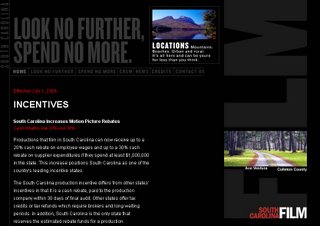Our Reputation is NOT Enough: Why Productions are Running Away from California

From its beginning, California has been at the heart of the motion picture industry. The studio system of the 1950s solidified the state, more specifically Los Angeles, into a powerhouse of studio and location filming. Ever since then, Hollywood has stood for the glamour and abundance of film. Yet during the past decade, California has slowly been losing its place at the top of the industry as an increased amount of states are now offering incentives (in the form of tax cuts and rebates) towards film productions, luring films away with the hope of a better budget. And California is hardly remaining competitive.
These incentives, which range from tax credits when $250,000 is spent (Arizona), to interest-free loans up to 15 million dollars (New Mexico), leave California outdated, whose policies seem only to have recently added fee-free filming on state property. And while groups such as the PGA are constantly lobbying towards the establishment of such an incentive here, Governor Arnold Schwarzenegger's office claims that California could not support it due to financial pressures. But by not supporting and implementing such a program, California is losing more revenue and jobs that productions would provide, forcing them to other states where locations and budgets are more feasible.
In addition to California's lack of incentives, it has also seen a dramatic drop in the amount of sound stages available to productions. Only one of the large Studios from the 50s era remains intact, while all others have sold their back lots. Working at 90% capacity, even Universal has hired developers, and is in the midst of deciding whether or not to keep their 30 sound stages open for use. And while other studios do boast of multiple stages, they do not have the space needed for large feature productions. Because of availability and space, productions are being forced to use old airplane hangers and warehouse buildings... or go out of state. Using large empty buildings puts added pressure on production, as these bigger facilities were not designed for filming. The Vice President of Operations for Downey's Studios admits, "You don't have power and you don't have support like props, painters, and the commissary, so you're bringing everything in." Without the addition of new, up-to-date facilities, California is practically pushing production and the revenue they bring out the door.

Groups such as Film LA have recently been created by filmmakers in the Los Angeles area. These groups have taken initiative and made processes such as appling for permits easier and more accessable to anyone. They also provide forums, and updates on productions and their policies. Their goal: keep production in the area. But unfortunately, this is not enough. In order to continue to be at the top of the industry, California needs to recognize that a well trained crew base and reputation will only help the state for so long. The persistant lure of other states' facilities and incentives will slowly drain away both of these resources as workers travel to find jobs.


0 Comments:
Post a Comment
<< Home